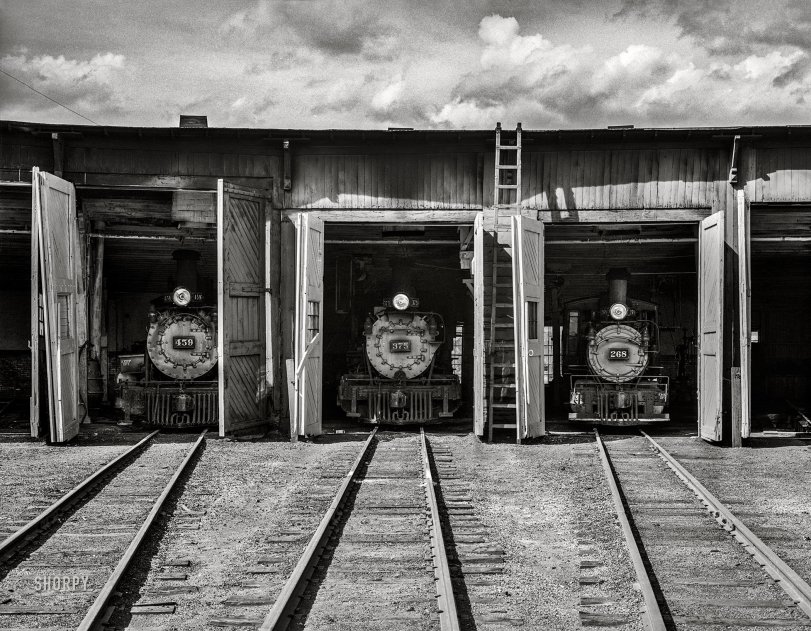


Framed or unframed, desk size to sofa size, printed by us in Arizona and Alabama since 2007. Explore now.
Shorpy is funded by you. Patreon contributors get an ad-free experience.
Learn more.

- Lofty addition
- In 1912
- Keenan Building
- Six years old
- Taken from the P.J. McArdle Roadway?
- It stood only 47 years
- Three track mind
- Incline to the right
- Reach for the sky, 1912 style
- No clean sweep
- Same Job Title, Same Face
- Sadly Lost
- Beautiful ...
- Where you get your kicks
- Aim High
- Pueblo Revival sisters
- Pueblo Neoclassicism
- Milk Man
- Regional dialect.
- Spielberg's inspiration
- Great Photo
- Loaf Story
- Do you still have the Rakes category?
- Could almost be a scene from the 1957 movie 'Hell Drivers'
- The Wages of Fear.
- Conspicuous by their absence
- Got Milk?
- All that aluminum
- No lefties
- Smoke 'em if you've got 'em
Print Emporium
Garage à Trois: 1940

September 1940. "Locomotives in roundhouse. Durango, Colorado." Medium format acetate negative by Russell Lee for the Farm Security Administration. View full size.
Now in Trois-D
Or at least a panoramic simulation:
The More Things Change.....
Same place (maybe), same scene, different century:
https://www.theatlantic.com/photo/2020/04/colorado-photos/610141/#img19
Keep talking
Without you "old geezers", all the knowledge of old locomotives, cars, appliances, vintage magazines etc. would vanish. You are the treasure of this site.
Missed Opportunity
Back in 2002, I spent several hours with Allen Harper, owner of the railroad, interviewing him about the Missionary Ridge Fire. He was very interested to learn that I was a steam locomotive geek as well as a wildland firefighter. So he gave me an open invitation to be an honorary fireman on one of the trips to Silverton. If I remember correctly, he said, "If the engineer likes you, you'll shovel 4 tons of coal on the trip. If he doesn't like you, you'll shovel 7 tons."
Fortunately or unfortunately, I never had a chance to take him up on his offer.
268 is still with us
Built in 1882, it is currently at the Gunnison Pioneer Museum. No. 268 was used in the filming of the movie "Denver & Rio Grande" in 1952.
Now ain't this the berries!
(as my late grandfather used to say)
We have a wild assortment of D&RGW head-end power waiting here:
- #459 was a class K-27 “Mudhen” Mikado (2-8-2), built by Baldwin in 1903 as job #21936. She served on multiple divisions of the road, and was eventually sold to Ferrocarril Nacional Mexicano, which renumbered her and converted her to standard gauge. She was finally scrapped in 1963.
- #375 was also Baldwin-built and also from 1903. A C-25 Consolidation (2-8-0), she began life as Crystal River Railroad #103; the Rio Grande bought her from CRR in 1916 and numbered her 432, changing to #375 in 1924. As a purchase rather than a factory order, 375 was the only representative of class C-25 on the road. She met the scrapper’s torch at Alamosa, CO in 1949.
- #268 still survives, though I’m not sure that was a good thing. She was built in 1882, again by Baldwin (construction number 6002), as a Consolidation. She had a tiny firebox—her grate was only 14 square feet—and only developed 16,000 pounds at the drawbar, from which her class number of C-16 came. She was such a light weight that she could only work branch lines (Crested Butte, Baldwin, Lake City) and the main line to Montrose, which almost no one else used. She was also used to pull the wrecking train that dismantled the Crested Butte branch in 1955. After that, #268 went on static display in Gunnison with a gaudily inappropriate paint job. Eventually, she was refitted in colours more appropriate to her age and station, and now is on exhibit near the Gunnison Pioneer Museum.
























On Shorpy:
Today’s Top 5